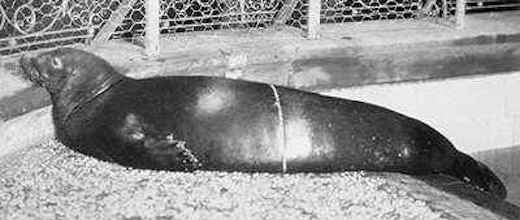Caribbean Monk Seal

Extinct 1952
Although most people associate seals with colder climates, there was a species of seals that existed in the Caribbean Sea until just a few decades ago. The Caribbean monk seal or “sea wolf” as it was called when first spotted by early European explorers during the 16th century. Although there are close relatives of this seal still living in the Mediterranean Sea and the Hawaiian Islands, all traces of its presence in the Caribbean Sea vanished after 1952.
They were first noticed by Europeans when Christopher Columbus landed on the isle of Alta Velo, just south of Hispaniola on his second voyage in 1494. He sent a party of men onshore who managed to kill eight seals that were resting on the beach for food. Over the next two centuries, the seals were heavily hunted for their oil which was used to lubricate machinery. By the 1850s, their numbers had dwindled to the point where they were no longer hunted and the remaining population became the focus of scientific study. Unfortunately, their inability to survive in captivity combined with their very low numbers had put them on the path to extinction.
What is the Caribbean Monk Seal?
They were seals which featured a long body that could grow up to eight feet in length and weigh up to 600 pounds. The males were slightly larger than the females and had much the same appearance as their Mediterranean Sea counterparts. The monk seal had a very distinctive head and face with large, widely-space eyes, upward nostrils and a large pad of whiskers as well. Their set of fore-flippers was somewhat short and featured rather small claws while their hind-flippers were thinner which helped propel the animal in the water.
Most Caribbean monk seals were brown or gray in color with the underside being somewhat lighter in color. Adults tended to be darker in color than their young who often exhibited a yellowish tone to their coloring. In addition, it was common for algae to grow on the pelage which offered a greenish tint to their appearance as well.
Habitat
The Caribbean monk seals were primarily found in the warm waters of the Caribbean Sea along with the Gulf of Mexico and the western part of the Atlantic Ocean. Their preference was to gather on the sandy beaches of isolated atolls and small islands. They rarely visit the mainland due mostly to the presence of humans and other predators. In addition, this particular species may have fed along the shallow reefs and lagoons that are found on many of the Caribbean islands.
Reasons for Becoming Extinct
The seals became extinct due to a combination of predators that primarily included man and sharks. The oil that seals produced in their blubber was considered highly valuable and their population was systematically reduced in large part because they were so docile and easy for men to hunt. The next factor was the reefs where they had fed on were over-fished by the growing population of people which left the remaining seals starving and highly vulnerable to sharks.
The seals were belatedly put on the endangered species list in 1967, but none had been seen since 1952. It is highly likely that by the time concern for their survival was placed in the forefront, they were already had disappeared.